
Intentional Self-Harm Hospitalizations and Emergency Department Visits at a Glance
Release date: February 2019
Highlights
- This report demonstrates the burden of self-harm on the health system by examining hospitalizations and emergency department (ED) visits rates due to intentional self-harm.
- Between 2008 and 2017, the ED visits rates for intentional self-harm increased in Durham Region residents. In 2017, there were 207 hospitalizations and 984 ED visits in Durham Region residents due to self-harm.
- Rates were higher in females than males. In 2017, the hospital and ED visit rates in Durham Region females were two times higher than the rates for Durham Region males.
- In recent years, the ED visits rates in Durham Region females were higher than Ontario’s rates while the ED visit rates in Durham Region males were similar to Ontario’s rates. Hospital rates for Durham Region residents were consistently lower than the provincial rates for females and males.
- Rates in youth aged 15 to 19 years were higher than any other age group, and ED visits rates doubled between 2008 and 2017. In 2017, Durham Region youth accounted for 23% of the hospitalizations and 27% of the ED visits.
- The most common method of self-harm was poisoning with one-third of the ED visits reporting the use of sedatives.
Figure 1: Age-standardized intentional self-harm hospitalization rates per 100,000 in Durham Region and Ontario, by sex, between 2008 and 2017
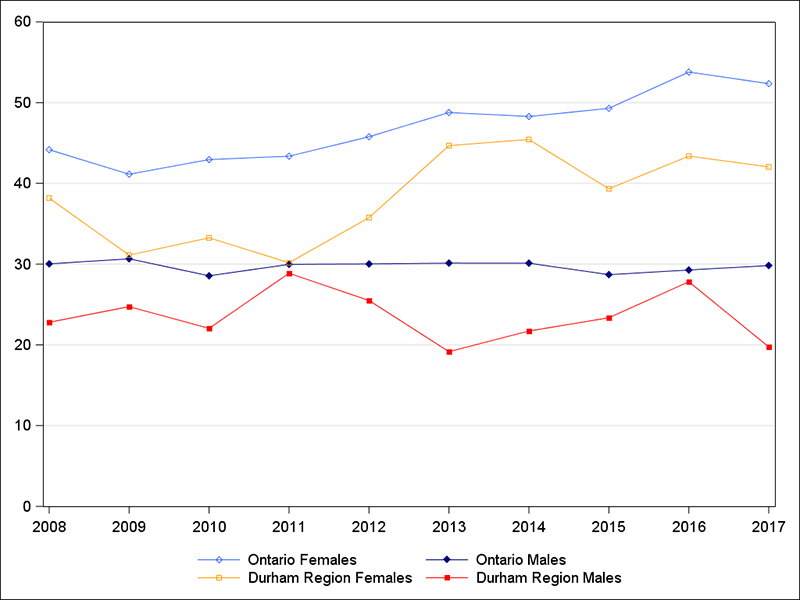
| Data table for figure 1 | ||||||||||||||||||||||||||||||||||||||||||||||||||||||||||||||||||||||||||||||||||||||||||||||||||||||||||||||||||||||||
|
||||||||||||||||||||||||||||||||||||||||||||||||||||||||||||||||||||||||||||||||||||||||||||||||||||||||||||||||||||||||
Figure 2: Age-standardized intentional self-harm ED visit rates in Durham Region and Ontario, by sex, between 2008 and 2017
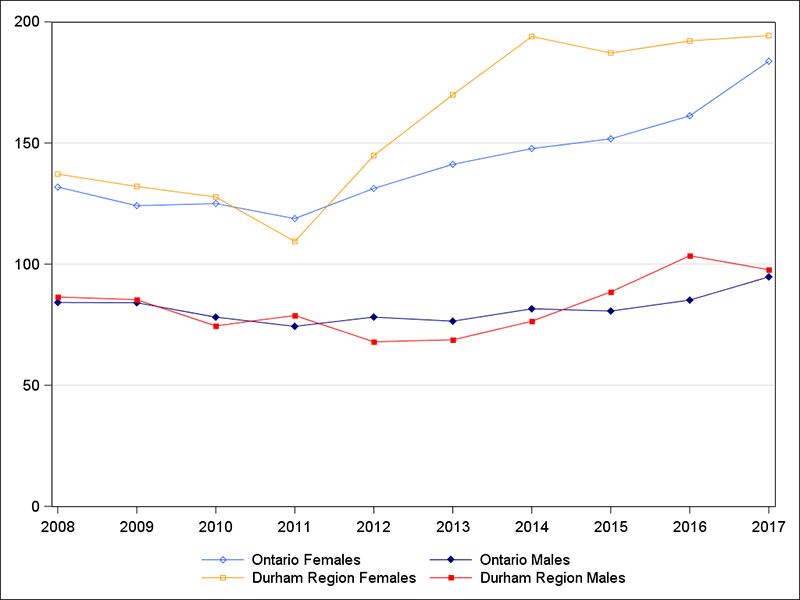
| Data table for figure 2 | ||||||||||||||||||||||||||||||||||||||||||||||||||||||||||||||||||||||||||||||||||||||||||||||||||||||||||||||||||||||||
|
||||||||||||||||||||||||||||||||||||||||||||||||||||||||||||||||||||||||||||||||||||||||||||||||||||||||||||||||||||||||
Figure 3: Age-specific intentional self-harm hospitalization rates per 100,000 in Durham Region and Ontario, individuals aged 0 to 14, 15 to 19 and 20 to 24 years, between 2008 and 2017
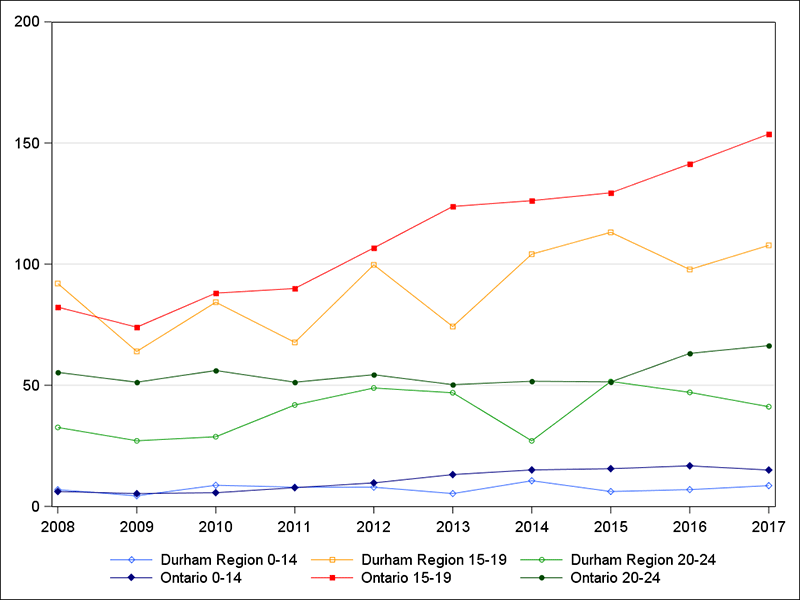
| Data table for figure 3 | ||||||||||||||||||||||||||||||||||||||||||||||||||||||||||||||||||||||||||||||||||||||||||||||||||||||||||||||||||||||||||||||||||||||||||||||||||||||||||||||||||||
|
||||||||||||||||||||||||||||||||||||||||||||||||||||||||||||||||||||||||||||||||||||||||||||||||||||||||||||||||||||||||||||||||||||||||||||||||||||||||||||||||||||
Figure 4: Age-specific intentional self-harm ED visit rates in Durham Region and Ontario, individuals aged 0 to 14, 15 to 19 and 20 to 24 years, between 2008 and 2017
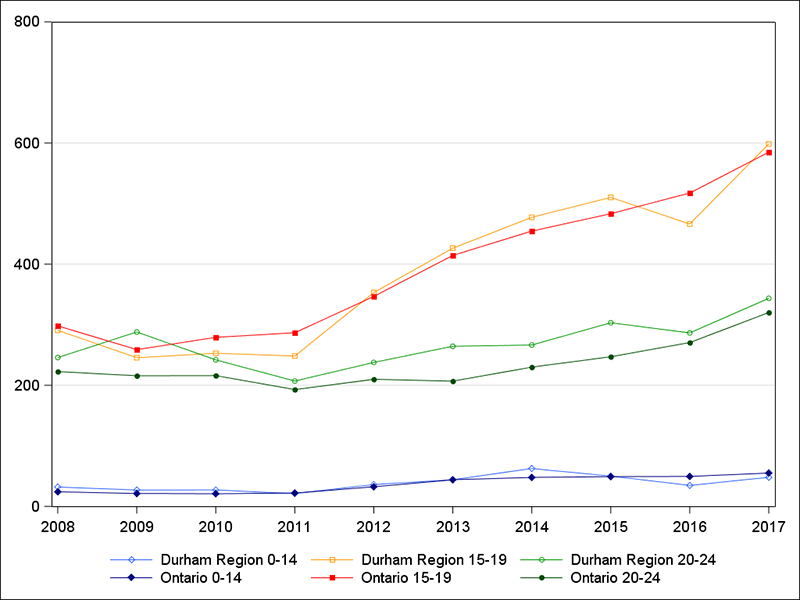
| Data table for figure 4 | ||||||||||||||||||||||||||||||||||||||||||||||||||||||||||||||||||||||||||||||||||||||||||||||||||||||||||||||||||||||||||||||||||||||||||||||||||||||||||||||||||||
|
||||||||||||||||||||||||||||||||||||||||||||||||||||||||||||||||||||||||||||||||||||||||||||||||||||||||||||||||||||||||||||||||||||||||||||||||||||||||||||||||||||
Figure 5: Per cent of intentional self-harm ED visit codes, by mechanism, in Durham Region and Ontario between 2008 and 2017
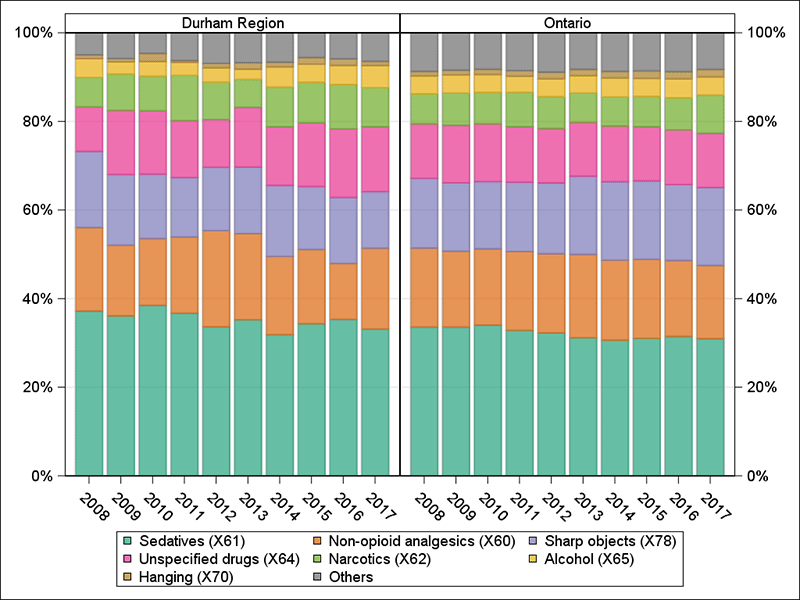
| Data table for figure 5 | ||||||||||||||||||||||||||||||||||||||||||||||||||||||||||||||||||||||||||||||||||||||||||||||||||||||||||||||||||||||||||||||||||||||||||||||||||||||||||||||||||||||||||||||||||||||||||||||||||||||||||
|
||||||||||||||||||||||||||||||||||||||||||||||||||||||||||||||||||||||||||||||||||||||||||||||||||||||||||||||||||||||||||||||||||||||||||||||||||||||||||||||||||||||||||||||||||||||||||||||||||||||||||
Data Sources
Hospitalization and ED visit data are collected by the Canadian Institute for Health Information (CIHI) on a fiscal year basis. For hospital visits, the main diagnostic code is the ‘most responsible diagnosis’ (MRD) that is deemed to be the clinically significant reason for the visits. For ED visits, the main diagnostic code is the 'main problem' (MP). Hospitalization and ED visit data provide only a crude measure of the burden of intentional self harm. Data are influenced by factors that are unrelated to health status such as availability and accessibility of care, administrative policies and hospital procedures. This may influence comparisons between areas and over time.
For all indicators, data are analyzed by the residence of the patient, not where the hospitalization or emergency department visit occurred. Ontario residents treated outside of the province are excluded. Hospitalizations to designated adult mental health hospital beds were not included in this analysis. Data are reported by calendar year, based on discharge year of the hospitalization or ED visit.
Intentional self-harm hospitalizations and ED visits were selected using a second set of ICD-10-CA codes, external cause codes (e-codes) X60-X84 (i.e., intentional self-poisoning by and exposure to sedatives) and Y87.0 (i.e., sequelae or 'late effects' of intentional self-harm one year or more from the original event). E-codes are not used as a MRD/MP but are used to classify the environmental events, circumstances and conditions that cause an injury. As multiple codes can exist for each hospitalization or ED visit, a unique visit number, the DAD key (hospitalizations) or NACRS key (ED visits), was used to count the number of hospitalizations or ED visits in Figures 1 to 4 where at least one of the above e-codes was captured. However; for figure 5, the mechanism categories are counts of e-codes; not counts of hospitalization or ED visits.
Definitions
Figures and tables are provided for the following indicators:
- Age-standardized intentional self harm hospitalization and ED visit rates by sex
- Age-specific intentional self harm hospitalizations and ED visit rates by individuals aged 0 to 14 years, 15 to 19 years and 20 to 24 years
Age-standardized hospitalization/ED visit rate
An age-standardized hospitalization/ED visit rate is the number of hospitalizations/ED visits per 100,000 that would occur if the population had the same age distribution as the 2011 Canadian population. This rate provides a single summary number that allows populations with different age compositions to be compared.
Age-specific hospitalization/ ED visit rate
An age-specific hospitalization/ED visit rate is the number of hospitalizations/ED visits in a specified age group per 100,000 in that age group. The numerator and denominator refer to the same age group.
For more information
Public Health Ontario Snapshots – interactive map-based dashboards for hospitalizations and emergency department visits due to injuries from intentional self-harm (ages 10+ only).
Contact Us




